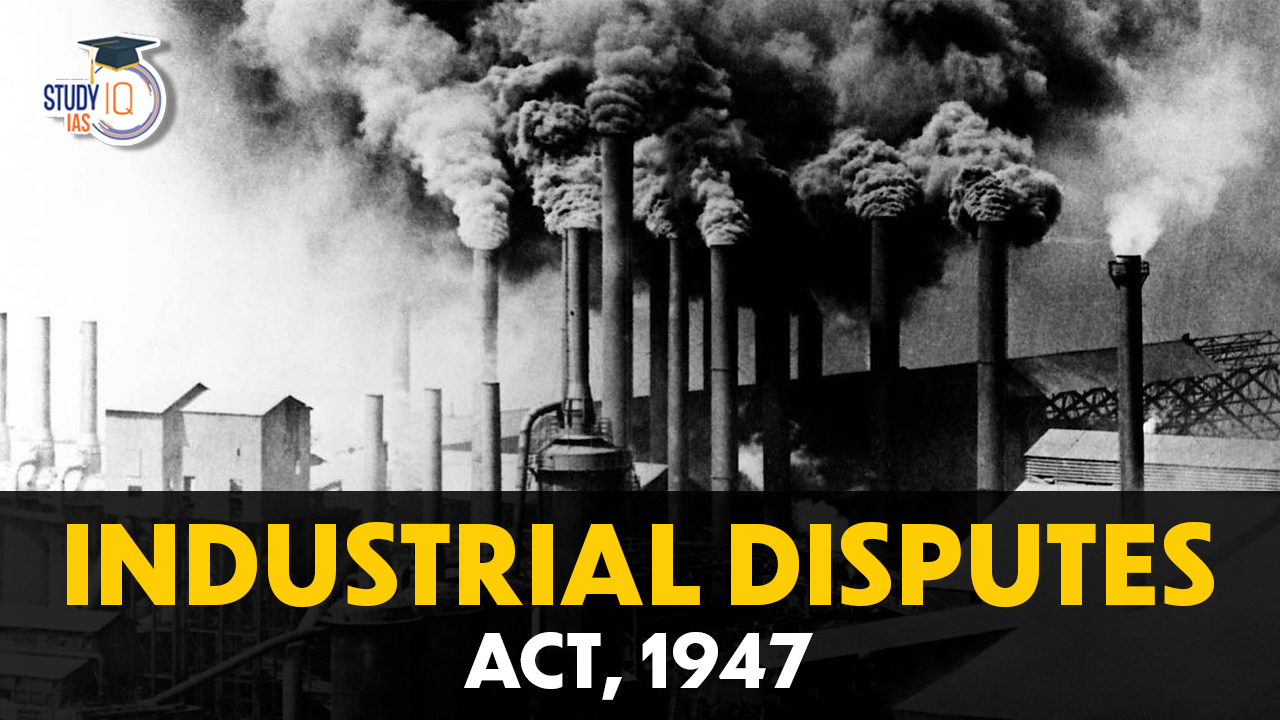Table of Contents
Industrial Dispute Act 1947
All workers employed on the Indian mainland are subject to the Industrial Dispute Act of 1947’s labour laws. April 1st, 1947 saw the implementation of this Act. Trade unions and employees in any industry in India are governed by Indian labor law under the Industrial Dispute Act of 1947. The Industrial Dispute Act of 1947 is crucial legislation in terms of the UPSC examination.
Industrial Dispute Act of 1947 is an important part of Economy which an important subject in UPSC Syllabus. Students can also go for UPSC Mock Test to get more accuracy in their preparations.
Industrial Dispute Act 1947 Introduction
To maintain fair terms between employers and workers, as well as between workers and employers, is the primary goal of the Industrial Disputes Act, 1947. It aids in not only preventing disputes between employers and employees but also in identifying ways to resolve them so that the organization’s output is not impeded. We’ll talk about the significance of the Industrial Disputes Act of 1947 in this unit..
The many authorities and their roles in dispute resolution are covered under this unit. Additionally, references to disagreements are discussed. You will learn about the various awards awarded by the various authorities under the Act through this unit. As a result, this unit will enable you to comprehend the conflict resolution processes, as well as the responsibilities of various agencies and the dispute resolution process.
The rules for the investigation and resolution of workplace disputes are primarily covered by the workplace Dispute Act of 1947. It encompasses all of India. The Central Legislative Assembly passed the Industrial Dispute Act in 1947. It was enacted on March 11th, 1947, and it went into effect on April 1, 1947.
Industrial Dispute Act 1947 Objective
The Industrial Disputes Act of 1947 established a framework and procedure for the investigation and negotiation of labor disputes with the goal of preserving peace and harmony in the workplace. Promoting constructive interactions between labor and industry and providing adjudication authorities with a method of settling disputes are two goals of the Industrial Disputes Act of 1947.
to create a committee to settle conflicts between employers and employees, with either an employer organization or a recognized trade union as its representative. Unauthorized lockouts and strikes are prevented by the Industrial Disputes Act of 1947. Speak with employees who have been fired unfairly or terminated, etc.
Industrial Dispute Act 1947 Feature
According to Section 2(a) of this Industrial Dispute Act 1947, average pay means the average of the wages of:
- Three full calendar months if being paid monthly
- In the event of a worker who is paid weekly, four full weeks.
- Twelve full working days, in the case of a worker who is paid daily.
According to Section 2(k) of the Industrial Dispute Act of 1947, a “industrial dispute” is any disagreement relating to employment, inactivity, or working circumstances between two or more parties:
- Employers and employers.
- Employers and workmen.
- Workmen and workmen.
According to Section 2(K) of the Industrial Dispute Act of 1947, layoffs occur when an employer refuses to hire a worker for the reasons listed below:
- Lack of coal, electricity, or raw materials
- Building up of stocks or
- Machine malfunctions
- A natural disaster or some related event
Lock-out (Section 2(l)) of Industrial Dispute Act 1947 refers to the
- The temporary closure of a workplace.
- A halt to work.
- Situation in which the company declines to keep hiring people
Retrenchment (Section 2(oo)) of the Industrial Dispute Act 1947 means the termination of a workman of the service by the employer for any reason. It does not include the following:
- Voluntary retirement.
- Retirement at the age of superannuation.
- Non-renewal of the employment contract.
- Continued illness.
Labour courts (Section 7) and Tribunals (Section 7A) of the Industrial Dispute Act 1947 shall consist of only one person appointed by the appropriate government. The following are the common qualifications for a presiding officer of a labour court or a tribunal:
- Judge of a High Court or
- The district judge or an additional district judge for a period of not less than three years or Deputy Chief Labour Commissioner (Central) or Joint Commissioner of the State Labour Department, having a law degree and at least seven years experience in the labour department, including three years of experience as a Conciliation Officer or
- Grade III officer of Indian Legal Service with three years of experience.
- Apart from the above, any person with the following qualifications can also be appointed as the presiding officer.
One person must make up a National Tribunal (Section 7B of the Industrial Dispute Act of 1947), which must be established by the national government. A former or active high court judge must serve as the tribunal’s presiding officer.
Industrial Dispute Act 1947 & Punishment under the Act
Under the Industrial Dispute Act of 1947, anyone who engages in an unfair labour practise faces a potential penalty of six months in prison, a maximum fine of Rs. 1,000, or both.
Any worker who starts or continues an illegal strike faces a punishment of up to one month in jail, up to a fine of up to fifty rupees, or both. According to the Industrial Dispute Act of 1947, any employer that starts or continues an illegal lockout faces a potential penalty of one month in jail, a maximum fine of Rs. 1,000, or both.
A possible six-month prison sentence, a maximum fine of one thousand rupees, or both may be imposed on anyone who provides financial support, incites others, or participates in an illegal strike or lockout. According to the Industrial Dispute Act of 1947, anyone who violates any clause of a settlement or award may be sentenced to a maximum of six months in prison, a fine, or both.
Also Read: Employees Provident Fund Organisation
Industrial Disputes Act, 1947 & Controversy Associated
Regardless of size or industry, everyone was subject to the investigation and resolution of industrial disputes under the terms of the Industrial Dispute Act of 1947. The Industrial Dispute Act included clauses describing the prerequisites for layoffs and industry closure.
A 60-day notice period with the reasons for closure must be given to the competent authorities by an industrial facility that employs more than fifty people. In 1982, it was raised once again to 90 days. For the permission of layoffs, closures, and retrenchments, it must first obtain prior clearance from the government authority if it employs more than 300 people. In 1982, the duration was once more raised to 90 days.
This clause’s primary goal is to prevent employers from arbitrarily hiring or terminating workers. The labour commissioner’s approval is required for such action. This has caused a number of issues in the labour market, including:
- Lower output by labour
- Lower investments
- Lower productivity
- Hesitation in hiring
- Lower overall manufacturing performance
- Foreign investors are deterred from investing in India.
Industrial Disputes Act, 1947 UPSC
By promoting industrial peace and concord, the Industrial Disputes Act of 1947 seeks to preserve a balance between the welfare of workers and that of business. It focuses on the technique and process for investigating and resolving labor disputes through statute-mandated conciliation, arbitration, and adjudication. Students can read all the details related to UPSC by visiting the official website of StudyIQ UPSC Online Coaching.


 Goods and Services Tax (GST), Objectives...
Goods and Services Tax (GST), Objectives...
 Directive Principles of State Policy (DP...
Directive Principles of State Policy (DP...
 World Oceans Day 2025, History, Theme, S...
World Oceans Day 2025, History, Theme, S...





















